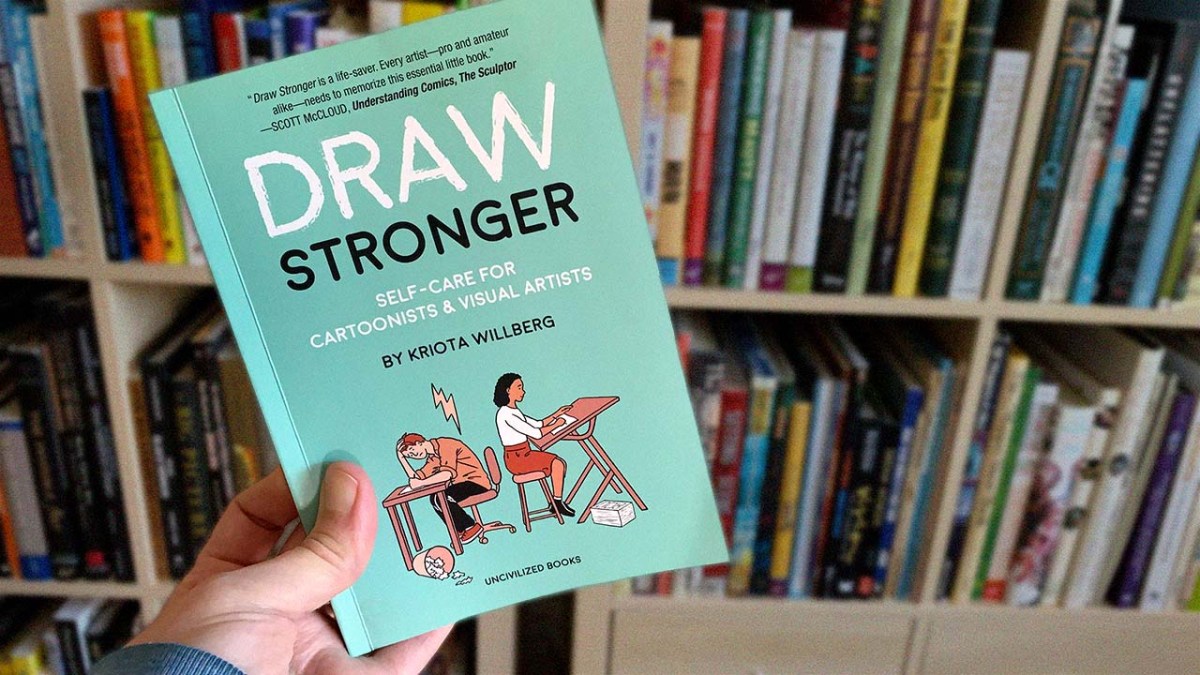Stanley Drucker became the principal clarinetist for the prestigious New York Philharmonic at age nineteen and retired from that position at eighty.
He worked as a professional artist for over sixty years.
Unlike professional athletes, professional artists can enjoy their craft for most of (if not their entire) lives.
Unfortunately, we often develop unhealthy work habits that increase the risk of serious problems like RSI, carpal tunnel syndrome and burnout.
Author/ illustrator, massage therapist and health science educator Kriota Willberg has devoted much of her long career to helping artists take better care of themselves.
She’s here today to share tips and insights from her book Draw Stronger: Self-Care For Cartoonists And Visual Artists.
Art Pain Starts In Your Brain:
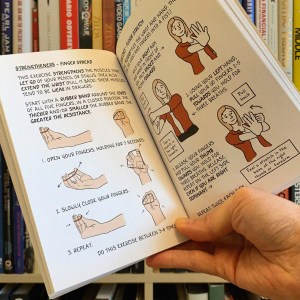
[Kriota] I think the most problematic idea that can lead to art-related injury is that you have to be suffering or under stress to be a better artist.
I know a number of artists with hand, finger or wrist pain but they brag about their calluses. They seem to think it’s proof that they’re more dedicated or more talented artists.
I think a callus proves that you’re gripping your stylus too tightly.
…but that’s about all it proves.
There’s quite a bit of the “No pain, no gain.” mentality amongst artists and creatives.
…but imposing physical pain on yourself doesn’t actually improve your technique.
…and it can actually make your technique worse over time.
Some people think taking breaks or doing things other than art is self-indulgent but it actually takes a lot of discipline to take regular breaks.
…and I can say that from my own personal experience. Sometimes, when I’m working on a project, one of my timer alerts will pop up, telling me to take a break and I’ll just dismiss it.
I think I have to keep working.
…but then what happens?
My neck starts to hurt or I get a headache.
I find that, amongst creatives, everybody is willing to sacrifice for their work.
…but what I would rather they sacrifice five minutes an hour instead of experiencing pain.
Art Injuries Can End Careers:
[Kriota] When you’re younger and you’re starting into a creative career and your body is more resilient, it’s easy to get into these habits that don’t yet have an impact.
…then ten, fifteen, twenty years later, it can be physically devastating for you.
There’s always someone who gets lucky.
They smoke cigars every day and have scotch for breakfast and they paint and never get injured and they become a symbol that other artists admire.
These admirers think that if they do the same thing they’ll have the same career.
But some people have worked hard to preserve their bodies and some people are just lucky.
[Chris] Yeah, you can always find outliers.
[Kriota] You can always find outliers.
It’s easy to model yourself after someone who may not have had such severe, career-ending injuries as someone else has had.
After writing Draw Stronger, I’ve gotten emails and I’ve talked to people who literally had to give up careers in comics and animation – in their twenties – because they were in so much pain they could no longer hold onto a stylus.
So, for me, the most common impediment to working and living injury-free (or at least with reduced pain or being able to cope with injuries) is the idea that it’s admirable, or it will make you a better artist if you just work hard and ignore your physical self.
What Are The Most Common, Art-Related Injuries?
[Chris] What are the sorts of physical injuries that take artists out? What literally happens to them?
[Kriota] Typically, artists experience repetitive stress injuries or “RSI.”
The name pretty much describes what causes the problem: Repetitive movements over time.
Although these movements don’t require a lot of strength, they can still fatigue the body, structurally, in different ways, just through constant motion. It’s like those little drips of water hitting the limestone.
Repetitive stress injuries, for artists, are usually some kind of tendonitis.
Sometimes people will get nerve impingements that come from pressure on nerves from other structures in the body. An example of that would be carpal tunnel syndrome. That’s usually a tendonitis and a nerve impingement simultaneously.
We can have muscle pulls and muscle spasm from poor posture.
Also, (and this isn’t covered in Draw Stronger) eye strain and chronic headaches…
There’s a plethora of things that are not musculoskeletal that can also affect artists, but a lot of principles that help you prevent musculoskeletal injuries (like carpal tunnel syndrome, etc.) can also help to reduce the frequency of eye strain, tension headaches, etc.
Can Art-Related Injuries Affect The Quality Of Our Work?
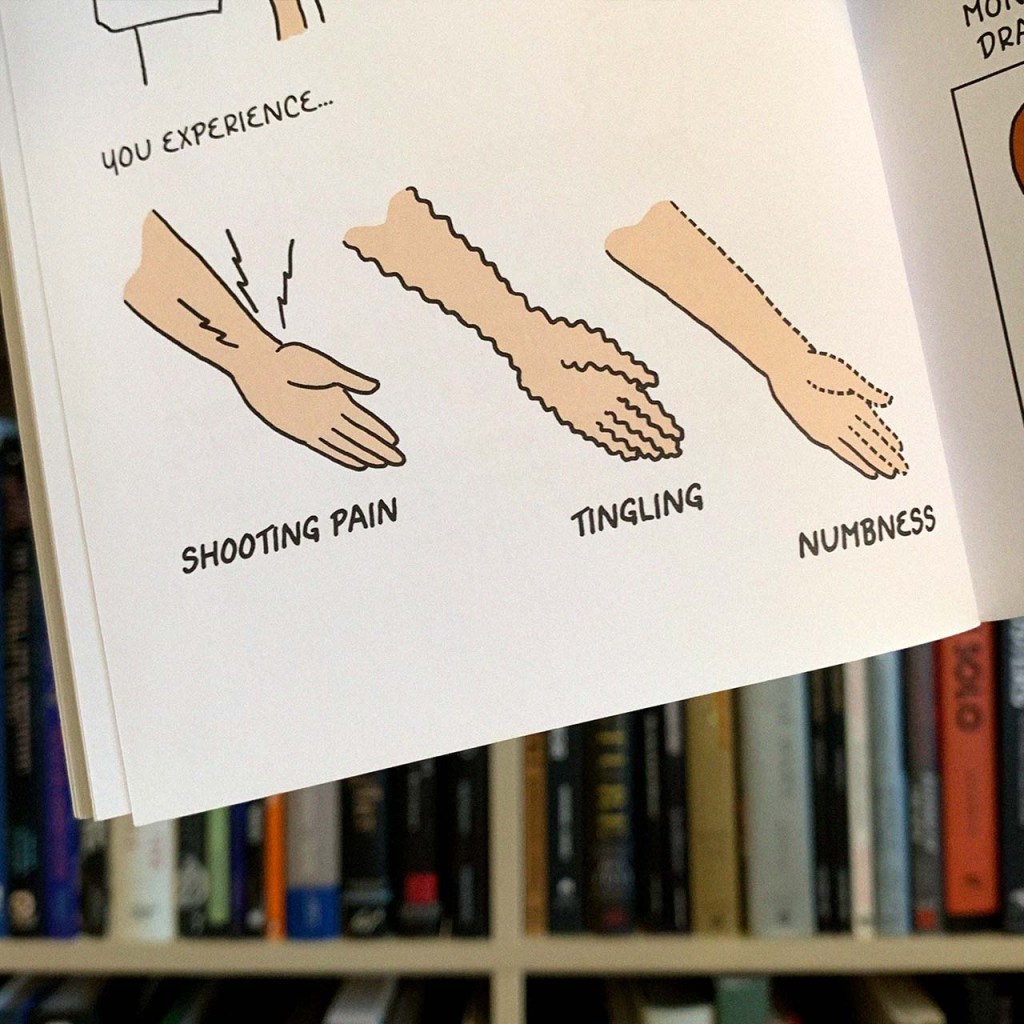
[Chris] In your book, you talk about how art-related injuries can negatively affect the quality of our art…
[Kriota] Yeah. Think of control over your stylus or pencil, brush etc. as technique. You have a way of working where you can control your speed, the precision of the movement, etc.
There are a number of things that your physical body is controlling so, if you become injured (if you have a tendonitis, if you have a nerve impingement, if you have muscle spasm, or if you’re in pain for other reasons), the pain will start to mess with your nervous system.
The muscles in your hand may be weaker or your nervous system may just be freaking out from the pain in your body, but it will cause you to get sloppier.
You’ll have less control over the technique of drawing or painting because of your injury.
So, you’re drawing or painting in pain but, also, your drawing or painting isn’t as good as it could be because of your pain.
You can’t just pop a pain killer and hope it goes away.
If An Artist Has Back, Hand, Wrist Pain Etc., When Should They See A Doctor?
[Chris] When should we see a doctor?
[Kriota] Nothing I’m saying here should not be taken as medical advice, right?
[Chris] Oh, yes. Of course.
[Kriota] In my book, there’s a list of cues for when you should see a doctor, but pain is one of the main indicators.
If you feel like you should see a doctor, you should definitely see a doctor.
Sometimes we need to get a diagnosis just to know what’s going on.
…because if it’s arthritis, that’s one thing. If it’s a sprain, that’s another thing. If it’s a tendonitis, that’s something entirely different. All of these things require different treatments, even if they’re happening in the same place.
So getting a diagnosis can help you get a more accurate treatment.
What Is The #1 Way Artists Can Avoid Back, Hand & Wrist Pain?
[Chris] What would you say is your number one tip for preventing art-related pain?
[Kriota] In general, breaks.
Take regular breaks.
If you’re healthy and you’re not trying to nurse an injury or tension headache or whatever, then you can probably take a break every hour and be fine.
If you are injured, you may have to take more frequent breaks.
You have to experiment with your own body to figure out what timing is best for you.
I get migraines that are triggered by computer screens. Because I do all of my work on a Cintiq, I have to take a five-minute break every twenty-five minutes.
During those breaks, I do some neck and shoulder stretching.
I don’t look at a screen at all.
With regular breaks and stretches, I can work an eight or ten hour day and usually not have a problem.
If I don’t take breaks, I get a migraine within two hours.
Depending on their health, age, etc., some artists may be able to work ninety minutes before taking a break. For people like me, they’re going to have to break every twenty-five minutes.
When you take a break, you have to stop doing any kind of replication of what you’ve been doing in your creative time. Don’t look at another screen. Don’t make fast, little movements with your hands or fingers. No screen time, no texting…
[Chris] No gaming…
[Kriota] I have little exercise routines written on Post-Its and placed around my desk. So I’ll just grab one, go in the living room, do a series of exercises for five minutes and get back to work.
Regular breaks and rest are the best for prevention but they’re also a partial treatment.
A Cautionary Tale About One Artist’s Wrist Cyst:
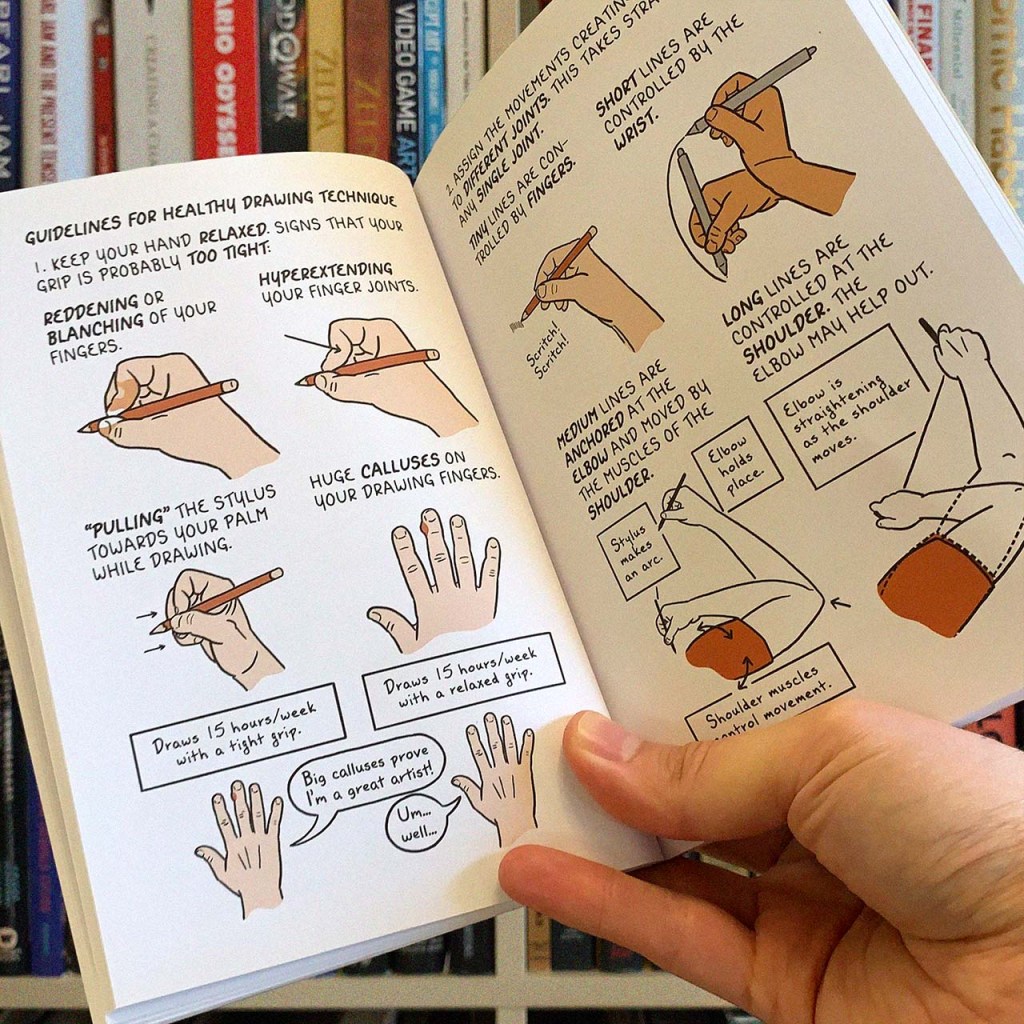
[Chris] I have a student who is one of the most motivated people I’ve taught in my almost-twenty years of teaching. She’s amazing.
There was a season in her career when she was saying “Yes” to every professional opportunity that came along.
She has a very demanding day job where she works as an artist. She was also, at the time, freelancing on nights and weekends, doing the same type of work. AND she was working on personal projects for her portfolio.
She developed a big bubble on the back of her hand, close to her wrist.
[Kriota] Yeah. It’s called a ganglion cyst.
[Chris] It was so severe that she couldn’t really draw or paint, but she kept working anyway…
Eventually, she went to see a doctor who told her she needed to stop working and rest until it subsided.
She told the doctor (I’m paraphrasing) that she needed a faster solution. She said she didn’t have time for rest or a medical procedure. She had deadlines and all these other demands…
So the story goes, the doctor said that some people would hit it with a book.
[Kriota] Yeah. That’s why they call it a “Bible cyst.”
[Chris] Oh my goodness gracious…
Well, she asked her personal trainer to do the honors.
She said the pain was excruciating.
As she tells the story, it did reduce the size of the cyst, but it didn’t go away.
…and the pain didn’t go away either.
She kept trying to work but she could only handle tiny little increments.
My point is, if you don’t take breaks, your body will take one for you.
[Kriota] Yeah. And it’ll be a lot longer than you want it to be.
The ganglion cysts are interesting. They used to be called “Bible cysts” because the home cure was to take the big, heavy family Bible and give it a whack.
They’re little round balls of fluid so hitting it with a book is supposed to burst it. But, depending upon how thick the covering is, and how hard the impact is, it may or may not actually burst.
…and I would not recommend to anyone to ask anybody to wail on their drawing wrist!
[Chris] Yeah! Under any circumstance!
[Kriota] They can be aspirated but whether someone pounds on it and screws up your wrist that way, or drains it with a needle, sometimes they’ll come back.
…if you keep up those irritating activities.
[Chris] So take breaks, folks.
[Kriota] Take breaks, yeah. Brakes are cheap and they actually work. I can’t recommend them enough.
…and like I said: Taking breaks takes a lot of discipline. It’s really hard to take a break when you’re right in the middle of something. I know how that is…
But I can also tell you from experience that if you don’t take those breaks, it’s going to catch up with you and there’s going to be trouble.
How Do You Remember To Take Breaks?
[Kriota] There are apps that you can get that will serve as timers for you and flash up on your screen or block your field of vision to remind you to take a break. I use one of those.
Some people just set a timer, but I always forget to reset it.
…so I just have this app on my computer that constantly nags at me.
[Chris] I used Rescue Time for a while and it fixed me.
…for a while.
My wrist keeps telling me I need to sign up again…
How Can Our Workspaces Help To Prevent Back, Hand & Wrist Pain?
[Chris] What about the workspace? What is your number one workspace tip?
[Kriota] Sit. Up. Straight.
Don’t slouch. You don’t necessarily need a special chair, but slouching is dangerous because it also affects the alignment of your arms and hands. It also puts a lot of stress on your neck and your back and your shoulders and your sacrum and your coccyx…
By improving your posture, you will help to take stress off those areas and it can help to reduce the likelihood of nerve impingement and other things like that.
Just shift your weight forward so you’re on the edge of your chair with your feet flat on the floor (or on the ring if you have an elevated chair) and bend your knees to ninety degrees.
If you have a chair with a saggy or cushy back and you tend to recline while working, try to sit on the edge of your chair.
If your paper or Cintiq is flat on the table or down at waist height, that’s going to be a problem.
Find a way to bring to elevate the surface.
If I’m at my desk, working on my Cintiq, I can adjust that.
There are portable drawing desks that you can raise and lower. They have a little handle so you can carry them around.
When I’m away from my main workspace, I draw on a tablet so I use my squishy purse as a tablet stand. You can do this with your sketchbook too.
Whatever you are drawing on, you need to get that surface higher so that you’re not slouching or bending your face down toward it.
[Chris] You really have to invest the time in making the adjustments, paying close attention to what is happening in your neck and shoulders and spine, your hands and wrists, etc.
[Kriota] Yeah. See how it makes you feel…
Do You Recommend A Standing Desk Or A Sitting Desk?
[Chris] Standing desk or sitting desk?
[Kriota] My answer is yes.
Because if you’re standing all day, then your feet and your legs are going to be more vulnerable to repetitive stress or chronic injuries. So it’s good to stand for some of the time and sit for some of the time.
My husband, (who is also a cartoonist) actually has a sit/ stand desk that will raise and lower. So he switches between sitting and standing throughout the day.
I have a desk that I sit at, but when the opportunity presents itself (like when I’m doing research instead of drawing), I put a cardboard box on top of the desk and plop my laptop on top of that.
The cardboard box solution works fine. Pursuing the principles are important.
The equipment can be good, but if you don’t have money, you can come up with creative ways to make it work without spending much (or any) money.
Just understand what the expensive equipment is trying to do and then find a cheaper way to do it. It won’t look as pretty, but who cares?
Should We Consider A Different Medium?
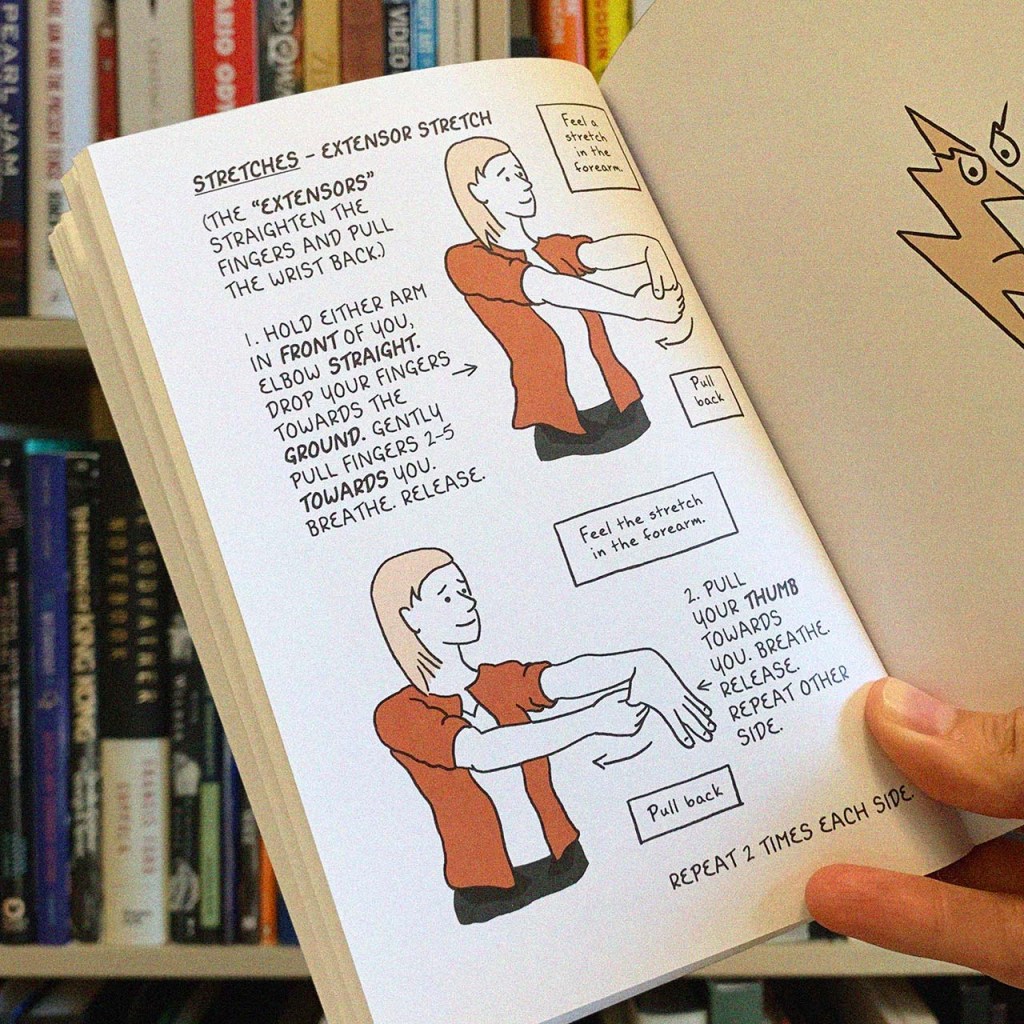
[Chris] You’ve recommended switching mediums as a solution for art-related injuries…
[Kriota] Yeah. For some people, if they’re in enough pain or the injury is bad enough, it may mean changing media or scale.
Maybe using a paintbrush instead of gripping a pencil…
I know a couple of people who prefer to draw on paper with a pencil but they’re recovering from their injury so, for a while, they can only draw on a Cintiq or on an iPad because the surface between the stylus and the screen is slippery enough that they don’t have to press as hard.
When they pick up a pencil and try to work on paper, they have to press harder and they have more pain so, if they still want to generate material, they have to use a stylus and screen interface.
Eventually, they will be able to make their way back to the surfaces that are causing trouble right now.
[Chris] Years ago, I switched from Cintiq to my Intuos5 and I never looked back. That seemed to fix my persistent back pain.
…and it made my Photoshop paintings better because I couldn’t zoom in as far or stay zoomed-in as long…
What Should We Do If We Forget To Practice Your First Two Tips?
[Chris] What I love most about your book is that it has a thorough collection of stretches and exercises – with illustrations and everything!
Could you share one of your favorite stretching tips?
…maybe one we can use if we forget to take breaks and sit up straight?
[Kriota] Imagine yourself hunched forward with your shoulders and spine curved while you’re drawing.
When you do this, the muscles in your chest start to shorten and tighten.
The muscles in your back get overstretched so they lengthen. They get stretched but they also hold you up.
…so they’re stretching and working at the same time.
When you’re done drawing, you stand up and your back feels tight.
What most people do is grab their hands, pull their arms forward, flex their spine and push into their back further.
They stretch the back of their body because that’s where they’re having pain.
…but the problem is they’re actually pushing themselves further into that slouching posture.
[Chris] That makes perfect sense.
[Kriota] So they’re stretching the muscles that are already too long.
Even though the back of the body is the part that usually feels painful and tight and wants stretching, therapeutically speaking, the part of your body that you actually need to stretch is the chest.
You need to pull your shoulders back and do chest stretches because that will help to lengthen the chest muscles and allow the shoulders to move further back when you’re standing up.
Sure, stretch your back a little bit, but then start stretching your front because that’s going to help more in the long-term.
Special thanks: To our guest Kriota Willberg, the team at Uncivilized Books for providing a review copy of Draw Stronger and for scheduling assistance, our Production Coordinator Mari Gonzalez Curia and Content Producer Mona Lloyd for editorial contributions to this post. The interview was lightly edited for grammar, clarity and time.
Get Our Free Artists’ Mindset Course:
Subscribe via email to get each lesson in our new artists’ mindset course, industry interviews and notifications about mentorship opportunities. It’s 100% free and we will always respect your privacy.
